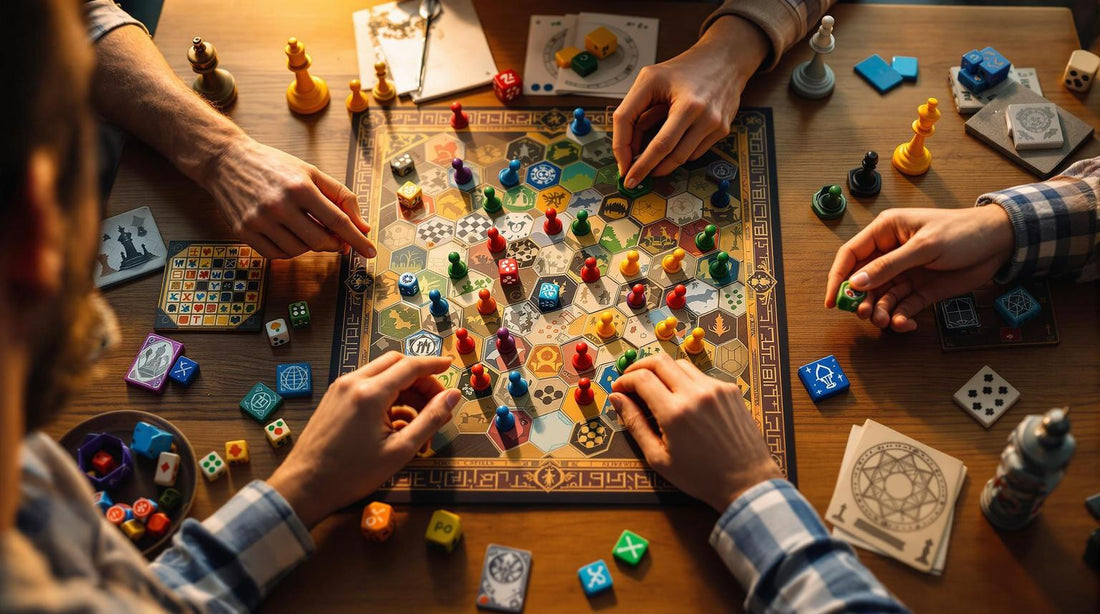Discover the Best Board Games for Every Player

Top 5 Two-Player Games for Strategy Fans
Looking for the best two-player games that balance quick playtime with deep decision-making? Here’s a breakdown of five standout strategy games, each offering unique mechanics and challenges:
- Lost Cities: A card game centered on risk vs. reward as you build expeditions with a clever scoring system.
- Onitama: A chess-like game with simple rules but endless strategic possibilities using movement cards.
- Sky Team: A cooperative aviation game where teamwork and dice placement are key to success.
- Schotten Totten: A tactical card game focused on area control and poker-like combinations.
- Tzaar: An abstract strategy game with piece capture and stacking mechanics for intense gameplay.
Quick Comparison
| Game | Complexity | Play Time | Main Mechanics | Replayability |
|---|---|---|---|---|
| Lost Cities | 2/5 | 30 min | Card management, set collection | High |
| Onitama | 2/5 | 15-20 min | Grid movement, area control | Very High |
| Sky Team | 3/5 | 30-45 min | Cooperative, dice placement | High |
| Schotten Totten | 2/5 | 20-30 min | Card management, area control | Moderate |
| Tzaar | 4/5 | 30-60 min | Abstract strategy, capture | Very High |
Dive into these games to experience engaging challenges, whether you prefer head-to-head competition or cooperative problem-solving. Each title is designed to deliver a rewarding strategic experience in under an hour.
Learn How to Play Onitama

1. Lost Cities
Lost Cities, created by Reiner Knizia, is a card game that pushes players to weigh risk against reward as they build expeditions. The game uses a 60-card deck divided into five colored expeditions. Each expedition includes cards numbered 2-10 and three special investment cards that can boost your score. However, starting an expedition comes with a -20 point penalty, making every decision to commit a strategic gamble.
On your turn, you face a simple yet tough choice: play a card or discard one. Cards must be played in ascending order, adding a layer of tension to every move. Investment cards add even more drama by multiplying your final score - whether it's positive or negative. Should you start early with low-value cards and hope to build up, or hold out for higher cards and risk losing them to your opponent?
This clever scoring system has helped Lost Cities achieve a 7.1/10 rating on BoardGameGeek from over 46,000 reviews. The game thrives on delivering tense, meaningful decisions. Its streamlined mechanics appeal to players who enjoy planning and tactical gameplay without the need for overly complex rules.
Lost Cities proves that you don’t need intricate systems to create a strategic experience. Its balance of risk and reward is a perfect lead-in to the next game, which draws its inspiration from martial arts strategy.
2. Onitama
Onitama shifts the focus from calculated risks to pure strategy with a chess-like approach. Created by Shimpei Sato, this game moves away from number-based tactics and dives into spatial planning and strategic foresight.
The game is played on a 5x5 grid, with each player controlling five pieces, including a Master pawn. Movement is dictated by two cards, but here's the twist: once you use a card, it goes to your opponent, and you draw a new one. Victory can be achieved in two ways - either capture your opponent's Master or move your Master to their Temple Arch. This dual-win condition keeps players on their toes, demanding adaptability.
With a playtime of just 15-20 minutes, Onitama is easy to pick up but offers layers of strategic depth.
| Game Feature | Detail |
|---|---|
| Playtime | 15-20 minutes |
| Win Conditions | Capture Master or reach Temple Arch |
| Card Combinations | 12,870 |
What sets Onitama apart is its reliance on skill rather than luck. Every move is visible to both players, ensuring a level playing field. Replayability is a standout feature, with the base game’s 16 movement cards offering 12,870 possible combinations. The rules are simple to learn, but mastering the game takes time and practice.
3. Sky Team

Switching gears from the abstract strategy of Onitama, Sky Team takes players into the high-pressure world of aviation. This cooperative game keeps the strategic depth high but adds a twist: teamwork is essential. Unlike the head-to-head battles of Onitama, Sky Team requires players to synchronize their moves perfectly, making it a very different kind of challenge.
In this game, you and a partner take on the roles of pilot and co-pilot, managing the intricacies of a flight using a dice placement system. While you're working together, there's a catch - you can't openly share your dice values or plans. This layer of hidden information makes communication indirect, adding tension and requiring creative problem-solving.
The gameplay revolves around three core tasks: managing fuel, optimizing dice placement, and balancing safety risks as the scenarios become increasingly complex.
| Key Features | Detail |
|---|---|
| Playtime | 20-30 minutes |
| Player Interaction | High |
| Replayability | Multiple scenarios |
Much like Lost Cities' balance of risk and reward or Onitama's spatial strategy, Sky Team offers its own unique spin. The game captures the feel of a cockpit through clever mechanics - like dry-erase flight boards that replicate real operations - and timed turns that keep the pressure on. With a strong BoardGameGeek rating of 8.0/10 from over 3,600 reviews, Sky Team combines theme and strategy in a way that keeps players coming back for more.
sbb-itb-1ed942f
4. Schotten Totten

Schotten Totten shifts the focus back to one-on-one competition, offering a tactical experience that echoes the risk-reward dynamic of Lost Cities. However, instead of card sequencing, this game emphasizes spatial control. With a 7.4/10 rating from over 14,000 BoardGameGeek users, it’s clear players enjoy its engaging mechanics.
This game blends straightforward rules with strategic depth. Players compete for control of nine border stones using a 54-card deck divided into six suits. Each turn forces you to make a critical choice: which card to play and where to place it. The scoring system, influenced by poker, adds a strategic twist - you’ll need to form combinations like three of a kind, straights, and flushes to claim stones.
| Game Element | Description |
|---|---|
| Playtime | 20-30 minutes |
| Complexity | Easy to learn, tough to master |
| Key Mechanics | Hand management, area control |
| Victory Condition | Claim 5 stones or 3 adjacent stones |
One of the game’s standout features is its bluffing aspect. While all played cards are visible, the real tension lies in outthinking your opponent. Should you play your strongest cards early to secure a stone, or spread them out for strategic advantage? This constant back-and-forth keeps the gameplay engaging and rewarding for strategy fans.
Every move matters, and for those looking for even more options, the Battle Line variant introduces special tactic cards. These add extra layers of strategy while staying true to the original game’s essence. Variants like this ensure the game remains fresh and replayable, appealing to both newcomers and seasoned players.
5. Tzaar
Tzaar wraps up our list with a pure strategy experience from designer Kris Burm, earning a solid 7.8/10 rating from 8,900 BoardGameGeek users. This game challenges players to balance bold moves with careful planning, embodying the essence of what makes two-player games so engaging.
The action takes place on a hexagonal board with three types of pieces: Tzaars, Tzarras, and Totts. Each turn, players must take two actions: first, capture an opponent's piece, and then choose between another capture or stacking their own pieces to strengthen their position. This dual-action system keeps the pressure high, requiring constant trade-offs between risk and reward.
| Game Element | Description |
|---|---|
| Playtime | 30-60 minutes |
| Complexity | Medium to High |
| Key Mechanics | Piece capture, stack building |
| Victory Conditions | Eliminate one piece type or outmaneuver opponents |
What sets Tzaar apart is its stacking mechanic. While stacking pieces increases their strength, it also reduces the number of pieces you have in play, forcing players to carefully manage their resources. Adding to the challenge, players must maintain at least one of each piece type throughout the game, making every move a mix of offense and defense.
The game’s depth comes from its constant decision-making. Every move influences not just the current turn but also future positioning, creating a chain reaction of strategic consequences. This design earned Tzaar the 2008 International Gamers Award for Best Two-Player Strategy Game, solidifying its reputation as a standout in the genre.
With simple rules and rich tactical possibilities, Tzaar is a masterclass in two-player game design. Its focus on core mechanics, paired with layers of complexity, makes it a must-play for fans of strategic challenges.
Game Features at a Glance
Here's a quick comparison of five standout two-player strategy games, highlighting the key aspects that matter most to fans of strategic challenges.
| Game | Complexity | Play Time | Main Mechanics | Replayability |
|---|---|---|---|---|
| Lost Cities | 2/5 | 30 min | Card management, set collection | High |
| Onitama | 2/5 | 15-20 min | Grid movement, area control | Very High |
| Sky Team | 3/5 | 30-45 min | Cooperative, dice placement | High |
| Schotten Totten | 2/5 | 20-30 min | Card management, area control | Moderate |
| Tzaar | 4/5 | 30-60 min | Abstract strategy, capture | Very High |
Each game offers a unique approach to strategy, catering to different tastes and skill levels. For instance, Lost Cities revolves around card sequencing and risk assessment, while Onitama challenges players with spatial thinking reminiscent of chess. Sky Team introduces a cooperative twist with dice placement mechanics, making teamwork essential. Meanwhile, Schotten Totten blends card management with area control, and Tzaar delivers a pure abstract strategy experience with its capture mechanics.
Replayability is a major strength across the board. Games like Onitama and Tzaar stand out for their endless variability, thanks to emergent gameplay that keeps every session feeling fresh.
If you're eager to try these titles, check out Brain Games for availability and pricing at https://brain-games.com.
Final Thoughts
From the expedition-building of Lost Cities to the abstract challenges of Tzaar, these games showcase the best in strategic game design. Each offers a distinct experience, drawing in strategy lovers with its depth and replayability. Their lasting popularity among players highlights their quality and appeal.
These games combine straightforward rules with layers of tactical depth. Lost Cities and Schotten Totten are perfect starting points for newcomers, while Onitama delivers chess-like strategy with a clever twist on movement mechanics. Sky Team shines as a cooperative game, demanding close teamwork, and Tzaar caters to fans of intricate abstract strategy. Whether focusing on head-to-head competition or cooperative problem-solving, each game challenges players to think critically and plan ahead.
What makes these games stand out is their ability to balance short playtimes with meaningful decisions. With Brain Games offering international access and a two-week exchange policy, players can easily explore these titles to find their perfect match.
These games are a testament to thoughtful design, offering a blend of tactical depth and replayability that makes them must-haves for any two-player game collection.
FAQs
Which game is played by two players only?
There are several games specifically designed for two players, offering intense head-to-head competition. These games focus on strategic decision-making and are tailored to create a balanced and engaging experience for both players.
Examples include Onitama, which uses variable card setups to keep each game fresh, Lost Cities, which relies on randomized card draws for unpredictability, and Sky Team, where evolving scenarios add new challenges. Each game is carefully crafted to ensure every match feels rewarding and competitive.






